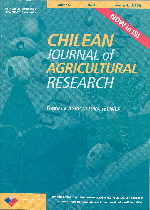
|
Agricultura Técnica
Instituto de Investigaciones Agropecuarias, INIA
ISSN: 0365-2807
EISSN: 0365-2807
Vol. 61, No. 2, 2001, pp. 192-201
|
 Bioline Code: at01022
Bioline Code: at01022
Full paper language: English
Document type: Research Article
Document available free of charge
|
|
|
Agricultura Técnica, Vol. 61, No. 2, 2001, pp. 192-201
| en |
Evaluation of the Quality Forest Site for Eucalyptus Camaldulensis Through Edaphic Indexes in Argiudolls and Argiacuolls, Argentina
Baridón, J.E.; Lanfranco, J.W.; Marlats, R.M. & Vázquez, M.
Abstract
The introduction of Eucalyptus sp. in the province of Buenos Aires, due to economic and market factors, make necessary to know the potential productíon of different sites. The development of yield models based on edaphic factors could be an alternative methodology in areas lacking biological indicators.
The aim of the project was to evaluate the quality of forest sites for Eucaliptus camaldulensis by means of an edaphic index methodology in Argiudolls and Argiacuolls. In addition the results were compared with in situ biological tests. The site indexes for Eucaliptus camaldulensis between both sites were significantly different at P≤ 0.05. Those trees growing ín the Typic Argiudoll had a median dominant height of 14.75 m while those growing in Typic Argiacuoll were only 11.5 m high. The difference between the indexes of each site was in agreement with the differences found between classes as determined by the methodology under study. Furthermore, the range of aptitude class established was sensible enough. The biological validity of the model shows that it is feasible to use it at least for those especies, soils and climates described. However, the methodology should be tested on other biological scenarios to establish absolute values.
Keywords
potential aptitude, biological test, forest site index, validation
|
| |
| pt |
Evaluación de la Calidad de Sitio Forestal Para Eucalyptus Camaldulensis Mediante Índices Edáficos en Argiudoles y Argiacuoles, Argentina.
Baridón, J.E.; Lanfranco, J.W.; Marlats, R.M. & Vázquez, M.
Resumo
La introducción de Eucalyptus sp. en la provincia de Buenos Aires, Argentina, debido a factores económicos y de mercado, hace necesario conocer el potencial productivo de los diferentes sitios. En zonas sin indicadores biológicos, la elaboración de modelos de pronóstico de rendimientos basados en indicadores edáficos podría ser una alternativa metodológica. El objetivo de este trabajo fue evaluar la calidad de sitio forestal para Eucalyptus camaldulensis mediante una metodología de índices edáficos en Argiudoles y Argiacuoles, confrontando los resultados con un ensayo biológico in situ. Los Indices de Sitio para Eucalyptus camaldulensis presentaron diferencias significativas (P ≤ 0,05) entre ambos suelos. Se comprobó la superioridad de los árboles instalados en el Argiudol típico (mediana de altura dominante = 14,75 m) sobre los instalados en el Argiacuol típico (mediana de altura dominante = 11,5 m). La diferencia entre los índices de sitio de los tratamientos se correspondió con una diferencia de clases determinada mediante la metodología evaluada, y el rango de clase de aptitud establecido fue lo suficientemente sensible. La validación biológica del modelo comprueba la factibilidad de su utilización para la especie, suelos y clima descritos; sin embargo, la metodología deberá ser contrastada en otras situaciones a los fines de establecer valores absolutos de sitio.
Palavras-chave
aptitud potencial, ensayo biológico, índice de sitio, validación
|
| |
© Copyright 2001 - Instituto de Investigaciones Agropecuarias, INIA (Chile)
Alternative site location: http://www.inia.cl/at/agritec.htm
|
|
